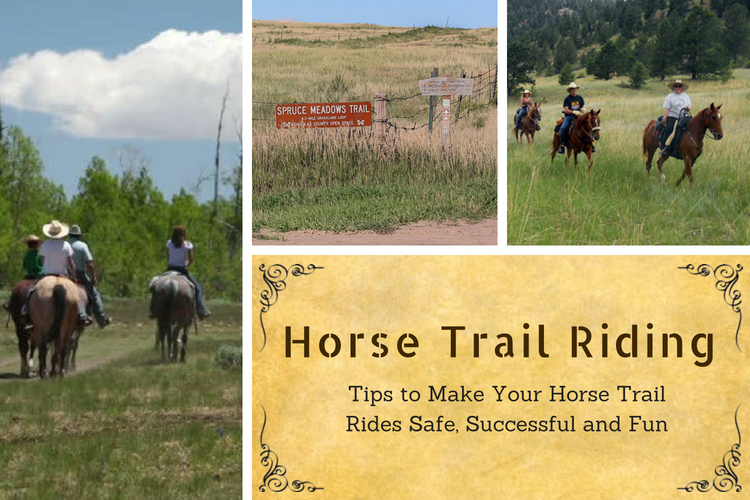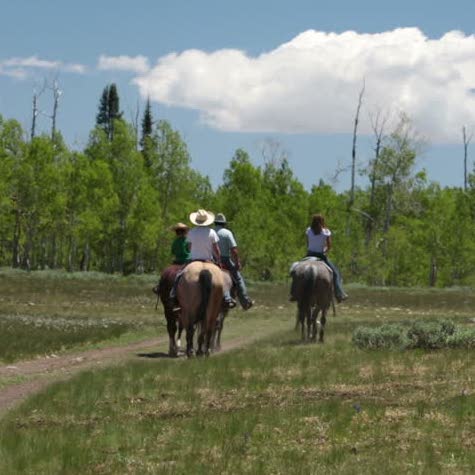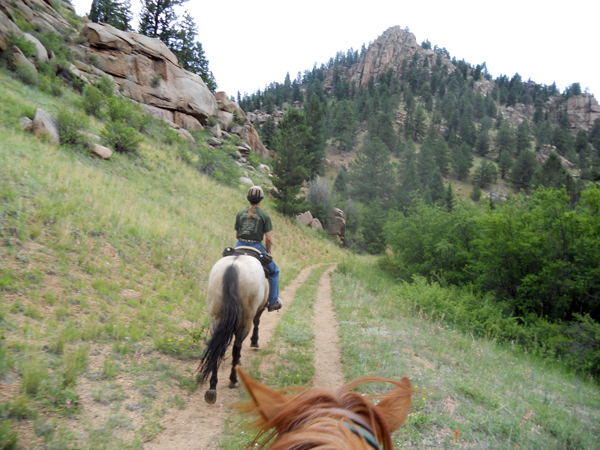Horse Trail Riding at Snow Creek Ranch Larkspur

Tips to Make Your Horse Trail Rides Safe, Successful and Fun
Whether you’re taking a short hack around your own property, a day trip with the gals, or even a multi-day group camp-out in the backcountry, horse trail riding is one of the most rewarding and enjoyable ways to spend time with your horse.
But even if you think you’re only heading out for a bit, your ride can be ruined if you’re not prepared.
So, since Snow Creek Ranch Equestrian has such easy access to so many beautiful horse trail rides, we thought it would be fun and useful to put together a few tips to help ensure that when you hit the trail, it doesn’t hit you back.
Health & Safety Tips for Horse Trail Riding
Always Bring Food & Water
First of all, always have water with you. Colorado is dry, and if you’re not paying attention, you can get dehydrated before you even realize how thirsty you are. Your horse can also overheat and may need to cool down as well. This is critical because the short horse trail ride you have planned can quickly turn into a longer than expected excursion thanks to getting lost or a rough fall.
It’s a good idea to have food with you as well – again, even if you only think you’ll be out horse trail riding for a short stretch. Non-bulky foods you don’t need to refrigerate are your best bet. Energy bars, Snow Creek Ranch Beef Jerky, nuts, or dried fruit are all great options.

Bring a First Aid Kit
Here, keep it simple. You’re not doing frontier surgery (we hope!), but a few basic items will prevent minor wounds from becoming medical emergencies.
- Band Aids – Assorted sizes for small cuts, blisters, & so forth
- 4-inch closure strips or butterfly closures – For closing large wounds. 4-inch strips are more effective than butterfly
- 4 inch by 4 inch sterile dressing pads (5 to 10) – To apply pressure to wounds & halt or slow bleeding
- Non-adherent sterile dressing (2 inch by 2 inch), or Second Skin – For covering blisters, burns or lacerations
- Gauze roll –Holds dressing in place
- Small roll of 1-inch adhesive tape – Holds dressings in place
- Painkillers – Aspirin or Ibuprofen for relief from minor aches and pains, fever reduction, inflammation from sprains and other minor injuries
- Space bag/blanket – Lightweight emergency shelter for for hypothermia
- Q-Tips – Helps you remove objects from the eye, or apply NeoSporin
- Antibiotic ointment (NeoSporin) – If you have an open wound, like a rope burn or a cut, this can really help prevent infections
- Antiseptic towlettes – Ideal for cleaning small wounds
Sunblock & a Hat
You live in Colorado. The sun is as brutal as it is beautiful here.
Bring a Multi-tool
As with hiking or mountain biking, when you’re out on the trail, anything can happen (and it often does). One of the most useful items to have on you when things get dicey on your horse trail ride is a leatherman-type folding multi-tool. You can use them to free your horse from rope, vines or other vegetation if they get tangled up, to pick your horse’s feet when necessary, to make minor saddle repairs, to pull splinters, and lots more.
A good, sharp pocketknife can be useful too, but doesn’t have the same versatility. Either way, keep it on you, rather than in a saddle bag, so you can get to it if you get separated from your trusty steed while horse trail riding.
Never Ride Alone
If anything happens to you or your horse, there’ll be no one around to help you, or to go get help. Also, this is just good, old-fashioned life advice.
First Aid for Your Horse
While it’s important to keep yourself healthy on the trail, you’ll need a few items to take care of your horse also.
- Bute – Also known by its medically correct name, Phenylbutazone, Bute is an anti-inflammatory drug that has no steroids. Basically this is a pain reliever, so if your horse has a minor sprain, stressed tendons or ligaments, or sore feet, you can give them Bute for temporary relief. It also reduces fevers and swelling.
- Probiotics – These help your horse maintain a proper balance of healthy bacteria in their gut. This balance can get thrown off anytime your horse’s routine is disrupted, and this can lead to a number of symptoms including apparent fatigue, upset stomach, or diarrhea. Ideally you would want to start giving probiotics with your horse’s feed about 3 days before your ride, as a preventative measure, so plan ahead! If you haven’t used probiotics before, consult your vet.
- Bug Spray – We all hate mosquitos. They’re irritating and carry diseases. Your horse hates them too, so be sure to pack some equine-specific insect repellent when you hit the trail. These sprays should repel flies, too, and can decrease the amount of flies you get in your stable as well.
Most sprays claim 14 days of fly control, but you may want to bring a bottle of one of these on the trail anyway: Endure Sweat-Resistant Fly Spray – Developed for use in sweaty or wet conditions. Equi-Spot – Easy to apply and effective spot-specific fly protection for 14 days. UltraShield Green – This natural, and eco-safe repellant works to repel biting flies, mosquitos, and gnats.
Good Stewardship While Horse Trail Riding

Good stewardship over our land is one of our most important values at Snow Creek Ranch. We believe the Earth and her animals are a gift, which it is our responsibility to protect and care for.
That doesn’t just go for our family-owned independent ranch. It also goes for the beautiful open space and trails that are an easy ride from our Colorado horse boarding stables. So here are a few additional tips to keep your footprint under control on your horse trail ride.
- Carry a small trash bag and pack litter out when you find it. As for your own trash, go by the old scouts saying: Take nothing but photos; leave nothing but footprints.
- When riding an established trail, help reduce overall wear by riding single file and don’t cut new switchbacks.
- If there’s no obvious trail, and you’re riding with a group, spread out. This will reduce the concentrated impact your horses have on the land. Your goal is to maintain the width and impact of the trail already present, reducing the amount of plants you tear out or trample and keeping erosion under control.
- Keep your horse hydrated in established stock-watering areas.
Etiquette for Horse Trail Rides
Take some time to make sure that if you are crossing private land you have permission to do so. Some property owners are happy to share the bounty with you. Others don’t want you on their pastures or rangeland.
Some landowners will let you know if there are areas on the property they’d like you to keep to. But then, some will just regard you and your party as trespassers. Respect their wishes.
Be polite and share the trail. Douglas County is full of active citizens, and you’ll be running across hikers, bikers, dog walkers and others. Offer them the right of way. If you and your horse can’t get off the trail, ask them to step off to the downhill side.
Practice good manure management also. If you can, keep your horse moving so there’s not a big pile blocking the trail. When spread out, road apples dry pretty quickly and are less smelly. If you’re trailering, clean up after yourself wherever you unloaded.

